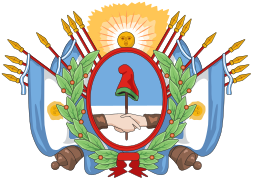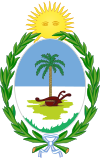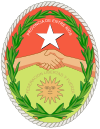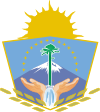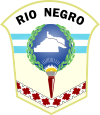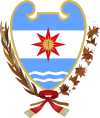Coat of arms of the Argentine Republic
The Coat of Arms of the Argentine Republic is —along with the Argentine Flag, the Argentine National Anthem and the Argentine Cockade — one of the four national symbols of the Argentine Republic. It was officially accepted on March 12, 1813 by the Constituent General Assembly of that year. Even so, documents issued by the Assembly are preserved that testify that before the decree approving its design was known, the current shield was already used, having used the coat of arms of the Viceroyalty of the Río de la Plata prior to it.
Argentina's coat of arms has the shape of an ellipse in the ratio 14:11. The ellipse on the main axis is divided between light blue (light blue) and silver or argen (white) and therefore remains in the national colors.
Despite the absence of legislative sanction, the fact that Manuel Belgrano used it as the central symbol of the pennant of the emancipating troops consecrated the emblem, being adopted by peoples and governments as a symbol of Argentine nationality.
The official historiography considers that the Assembly of the Year XIII commissioned the deputy for San Luis, Agustín Donado, to be in charge of making the seal with which the Government documentation would be authenticated, the definitive engraving of said seal was made by the goldsmith Juan de Dios Rivera who seems to have been inspired by a shield used by the Jacobins during the French Revolution.
The AGN contains the decree of March 12, 1813 signed by Hipólito Vieytes and Tomás Antonio Valle, secretary and president respectively of the Assembly, which orders:
May the Supreme Executive Power use the same seal of this Sovereign Corps with the sole difference that the inscription of the circle is that of Supreme Executive Power of the United Provinces of the Rio de la Plata.
After some modifications in the design of the shield, the current design was finally sanctioned on April 24, 1944 by Decree Law No. 10,302 of the National Executive Power, establishing that the original design be used exclusively.
Background
French safe-conduct coat of arms
The emblem used as laissez-passer (safe-conduct ticket) by the members of a French revolutionary club to gain access to the Legislative Assembly between 1790 and 1793 has a clear similarity with the Argentine coat of arms, except that it has marine references in blue, instead of celestial references, and the sun is not the Sun of May, from Inca references. It appears in an illustration that appears in the work The French Revolution, by Michel Vovelle (Volume 3, page 216). In the National Library of France it appears as "Collection Code Qb.1 Year 1793". Possibly the design had been obtained by an Argentine during that turbulent period or carried by a Jacobin who might have traveled to fight for Argentine independence (we may recall that Mme. Elisa Pichegru was a Jacobin who later took refuge in what is now Argentina and a close friend of Manuel Belgrano). This credential was already used two decades before the Constituent General Assembly of 1813 resolved to adopt the well-known national coat of arms.
Description
The initials "BR" that appear in a circle under the red ribbon that joins the laurels mean "Bibliothèque Royale", which is why the royal crown is also included. The letters "Lat" that can be seen on the right edge of the shield, at the height of the second and third rays of the sun, correspond to the "Colección Latarrade" of which that print was a part and whose owner of the same name sold a part to the National Library of France in 1841. In turn, the Latarrade family, in 1863, donated another fifteen thousand prints to the same institution, from which arises that the origin of the aforementioned emblem is perfectly certified.
Official coat of arms
Custom Shield
It is known that the Assembly of the year XIII, with the purpose of executing sovereign acts, commissioned the deputy for San Luis, Mr. Agustín Donado, to make a seal to authenticate the government's writings, replacing the one used until then with the royal arms of Spain, and which would also serve to mint the first national currency. It is also proven that Donado entrusted this task to the Cuzco engraver Juan de Dios Rivera based in Buenos Aires and that, with the stamp carved by him, some documents emanating from the Assembly were sealed; finally, in the General Archive of the Nation there is the decree of March 12, 1813, by which the Constituent General Assembly, with the signatures of its president, Tomás Valle, and the secretary Hipólito Vieytes, orders "that the Supreme Executive Power uses the same seal of this Sovereign Body, with the only difference that the inscription of the Circle is that of the Supreme Executive Power of the United Provinces of the Río de la Plata».
With this formality, the certain date of the creation of the Argentine coat of arms was recorded, even though «El Redactor de la Asamblea» published the news the following day.
Paternity of Design
From there the divergences begin about who was really the author of the respective design. It has been attributed to Donado himself, to the carver Rivera, to the Peruvian artist Isidro Antonio de Castro and to the Argentine from Tucumán Bernardo de Monteagudo, among others, but always making the caveat that there are no conclusive records that allow us to sustain with complete certainty who of the named it is possible to assign the paternity of the shield.
Symbolism
The elliptical shape (wrongly called "oval") of the body of this shield (one of the first national shields in the American continent) corresponds to the view of the upper profile of a human head since at she accommodates a laurel, such an elliptical shield is divided into two fields: the one in the upper half is enameled azur (sky blue) and the one in the lower half is enameled silver (white), that is to say: the colors of the stripes of the Argentine flag.
Other symbols are added to this basal design. The naked human forearms that shake their right hands are credited with the twinning of the provinces that make up the United Provinces of the Río de la Plata, a direct antecedent of the current Argentine Republic; the Phrygian cap or pileus directed to the left (Jacobin sign), gules (or punched), symbolizes freedom and is held by both hands on a symmetrical vertical pike in the middle of the fields of the shield that it symbolizes the commitment of the provinces to defend freedom (in Roman Antiquity there was a ceremony by which someone was recognized free by being touched with a pike on their head). The Sun of May that in the shield is located as a ring in the shape of the Rising Sun in the ring and chief, crowning the shield is this rising sun although a figured meridian with 21 straight and flaming rays alternating gold (yellow) that symbolizes the birth of the new nation, according to the phrases of the Argentine National Anthem: A new and glorious Nation rises on the face of the Earth, such a sun is predominantly painted in gold enamel, and drawn with straight rays and alternate flamboyant symbolizes the new nation. The Laurea (or the laurels) arranged as crowning the head of all Argentines represent the victory and triumph in the achievement of independence, and as the Anthem says, they must be maintained. Finally, the ribbon in the form of a bow (another sign of union) with the colors blue (in this case: sky-blue) and silver (white), the same as the quarters of the shield, represent the Argentine nationality that is emblematized in the colors of a daytime sky.
Historical shields
Shield of the Autonomous City of Buenos Aires and of the provinces of the Argentine Republic
Contenido relacionado
Laika
Kingdom of Asturias
Martinique








